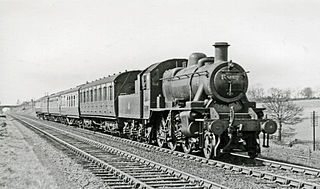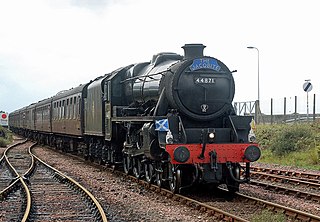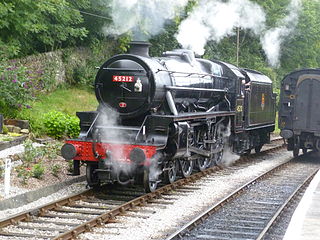This article needs additional citations for verification .(March 2024) |
| LMS 44871 | |||||||||||||||||||||||||||||||||||||||||
|---|---|---|---|---|---|---|---|---|---|---|---|---|---|---|---|---|---|---|---|---|---|---|---|---|---|---|---|---|---|---|---|---|---|---|---|---|---|---|---|---|---|
 | |||||||||||||||||||||||||||||||||||||||||
| |||||||||||||||||||||||||||||||||||||||||
| |||||||||||||||||||||||||||||||||||||||||
| |||||||||||||||||||||||||||||||||||||||||
| |||||||||||||||||||||||||||||||||||||||||
LMS Stanier Class 5 4-6-0 No. 44871 is a preserved British steam locomotive. It was built at Crewe Works in 1945.
This article needs additional citations for verification .(March 2024) |
| LMS 44871 | |||||||||||||||||||||||||||||||||||||||||
|---|---|---|---|---|---|---|---|---|---|---|---|---|---|---|---|---|---|---|---|---|---|---|---|---|---|---|---|---|---|---|---|---|---|---|---|---|---|---|---|---|---|
 | |||||||||||||||||||||||||||||||||||||||||
| |||||||||||||||||||||||||||||||||||||||||
| |||||||||||||||||||||||||||||||||||||||||
| |||||||||||||||||||||||||||||||||||||||||
| |||||||||||||||||||||||||||||||||||||||||
LMS Stanier Class 5 4-6-0 No. 44871 is a preserved British steam locomotive. It was built at Crewe Works in 1945.

4871 is an LMS Stanier Class 5 4-6-0 locomotive, originally numbered 4871 entering service with the London, Midland and Scottish Railway (LMS) in March 1945 and having 40000 added to its number under British Railways after nationalisation in 1948. [1]
44871 was one of the last steam locomotives to be withdrawn from service, surviving until August 1968, the last year of steam on British Rail. [1]
She was also one of four locomotives chosen (among two other members of her class) to take part in the famous Fifteen Guinea Special on Sun 11 August 1968. 44871 was in-charge of the Carlisle Citadel to Manchester Victoria leg of the tour which went south down the Settle and Carlisle Line. On this leg of the tour she double headed with 44781, 44871 acted as the pilot engine with 44781 being the train engine. 44871 is one of the three locomotives from that train to survive into preservation, the others being 45110 and 70013 Oliver Cromwell. [2]
| Location | Shed code | From |
|---|---|---|
| Longsight | 9A | 1 August 1948 |
| Crewe North | 5A | 6 October 1951 |
| Holyhead | 7C | 26 January 1952 |
| Crewe North | 5A | 14 June 1952 |
| Stoke | 5D | 12 July 1952 |
| Crewe North | 5A | 3 October 1953 |
| Stoke | 5D | 31 October 1953 |
| Crewe South | 5B | 22 March 1958 |
| Stoke | 5D | 18 June 1960 |
| Stockport Edgeley | 9B | 1 December 1962 |
| Trafford Park | 9E | 22 June 1963 |
| Stockport Edgeley | 9B | 6 November 1965 |
| Bolton | 9K | 11 May 1968 |
| Carnforth | 10A | 6 July 1968 |
44871 was purchased directly from British Rail service for preservation, and so never had to be restored from scrapyard condition unlike other preserved locomotives which were sent to Barry Island. The majority of the Class 5s were purchased directly for preservation, with only six being purchased from Barry Island and thus requiring restoration to run again.
Following withdrawal from revenue service 44871 remained at Carnforth, which would later become the Steamtown museum. Once the ban on operating steam locomotives over the national network was lifted in 1972, 44871 was used to operate mainline trains to places like York. It was during this period that she was given the name Sovereign. 44871 was also a popular engine in Scotland, working trains along the West Highland Line from Fort William to Mallaig (which she still runs decades later) working West Coast Railways "Jacobite trains" for most of the year, alongside sister No. 45407 The Lancashire Fusilier and LNER K1 No. 62005.
Following years of storage and the death of her owner in 2006, 44871 was purchased by Ian Riley and was taken to Bury for an overhaul to mainline standards. She returned to steam in 2009 and later undertook light and loaded test runs on the mainline alongside use on WCR's "Jacobite" trains. In the summer of 2010, she worked the final season of WCR's "Cambrian" trains along the Cambrian Line from Machynlleth to Pwllheli (the trains on Monday, Wednesday, and Friday ran to Pwllheli while the trains on Tuesday Thursday ran to Porthmadog). It isn't currently possible to run steam trains down the Cambrian line since they are incompatible with the new ERTMS system that was put in place.
In August 2010, 44871 was featured in an episode of Coronation Street where she hauled Roy and Hayley Cropper's wedding train. 44871 carried 45407's "Lancashire Fusilier" nameplates for the occasion.
44871 is based at the East Lancashire Railway alongside sibling No. 45407 The Lancashire Fusilier, both of which are mainline certified regular used for West Coast Railways Jacobite along the West Highland Line from Fort William to Mallaig and back. She returned to service in August 2017 following the completion of another heavy overhaul which was done to mainline standards as before.
In Summer 2021, 44871 was hired by the North Yorkshire Moors Railway, working between Whitby and Pickering, North Yorkshire.

The East Lancashire Railway is a twelve-and-a-half-mile (20 km) heritage railway line in North West England which runs between Heywood, Greater Manchester and Rawtenstall in Lancashire. There are intermediate stations at Bury Bolton Street, Burrs Country Park, Summerseat and Ramsbottom, with the line crossing the border into Rossendale serving Irwell Vale and Rawtenstall. Before closure, the line terminated at Bacup.

The London, Midland and Scottish Railway (LMS) Princess Royal Class is a class of express passenger 4-6-2 steam locomotive designed by William Stanier. Twelve examples were built at Crewe Works, between 1933 and 1935, for use on the West Coast Main Line. Two are preserved.

The London, Midland and Scottish Railway (LMS) Jubilee Class is a class of steam locomotive designed for main line passenger work. 191 locomotives were built between 1934 and 1936. They were built concurrently with the similar looking LMS Stanier Class 5 4-6-0. They were nicknamed Red Staniers and Jubs.

West Coast Railways (WCR) is a railway spot-hire company and charter train operator based at Carnforth MPD in Lancashire. Using buildings and other facilities previously owned by the Steamtown Carnforth visitor attraction, in June 1998 the company became the first privately owned company to be given a licence as a train operating company.

The London, Midland and Scottish Railway (LMS) Stanier Class 5 4-6-0, commonly known as the Black Five, is a class of 4-6-0 steam locomotives. It was introduced by William Stanier and built between 1934 and 1951. A total of 842 were built initially numbered 4658-5499 then renumbered 44658-45499 by BR. Several members of the class survived to the last day of steam on British Railways in 1968, and eighteen are preserved.

The London, Midland and Scottish Railway (LMS) Stanier Class 8F is a class of steam locomotives designed for hauling heavy freight. 852 were built between 1935 and 1946, as a freight version of William Stanier's successful Black Five, and the class saw extensive service overseas during and after the Second World War.

The London, Midland and Scottish Railway (LMS) Hughes Crab or Horwich Mogul is a class of mixed-traffic 2-6-0 steam locomotive built between 1926 and 1932. They are noted for their appearance with large steeply-angled cylinders to accommodate a restricted loading gauge.

The London, Midland and Scottish Railway (LMS) Ivatt Class 2 2-6-0 is a class of steam locomotive designed for light mixed traffic.

The London, Midland and Scottish Railway Compound 4-4-0 was a class of steam locomotive designed for passenger work.

London, Midland and Scottish Railway (LMS) Stanier Class 5 4-6-0 No. 5305 is a preserved British steam locomotive. In preservation, it has carried the name Alderman A.E. Draper, though it never carried this in service. It was named after Albert Draper, the man who rescued the locomotive in his own scrapyard.

Stanier Class 5 4-6-0 5231 is a preserved British steam locomotive. In preservation, it has carried the names 3rd (Volunteer) Battalion The Worcestershire and Sherwood Foresters Regiment and The Sherwood Forester, though it never carried either of these in service.
Compass Tours was a UK railtour organiser specialising in excursions with heritage diesel locomotives such as the Class 37, Class 40 and Class 47 and also using Steam Engines such as the LMS Black 5.
The Aberystwith and Welsh Coast Railway was a standard gauge railway company, running a line along the west coast of Wales.

The Fifteen Guinea Special was the last main-line passenger train to be hauled by steam locomotive power on British Rail on 11 August 1968 before the introduction of a steam ban that started the following day, the extra day added to allow for the movement of locomotive BR Standard Class 7 70013 Oliver Cromwell to Bressingham Steam Museum. It was a special rail tour excursion train organised for the occasion from Liverpool Lime Street via Manchester Victoria to Carlisle and back, and was pulled in turn by four steam locomotives during the four legs of the journey. The last scheduled standard gauge steam-hauled passenger services had run on 3 August 1968 from Preston. Steam continued to be used on the narrow gauge Vale of Rheidol Railway under British Rail, which was subsequently privatised in 1989.

LMS Stanier Class 5 4-6-0 No. 44806 is a preserved British steam locomotive. It was built at Derby in 1944.

The Jacobite is a steam locomotive-hauled tourist train service that operates over part of the West Highland Line in Scotland. It has been operating under various names and with different operators every summer since 1984. It has played an important role in sustaining a scenic route.
Peter Leslie Beet was an English general practitioner notable for his pioneering work in the preservation of steam locomotives.
Carnforth MPD (Motive Power Depot) is a former London Midland and Scottish Railway railway depot located in the town of Carnforth, Lancashire, England.

Albert Reginald Hitchen was an English professional road racing cyclist, who had also trained as an engineer with British Railways, becoming later known for his work in the preservation of steam locomotives.

LMS Stanier Class 5 4-6-0 No. 45212 is a preserved British steam locomotive. It was built by Armstrong Whitworth at Newcastle upon Tyne in 1935.